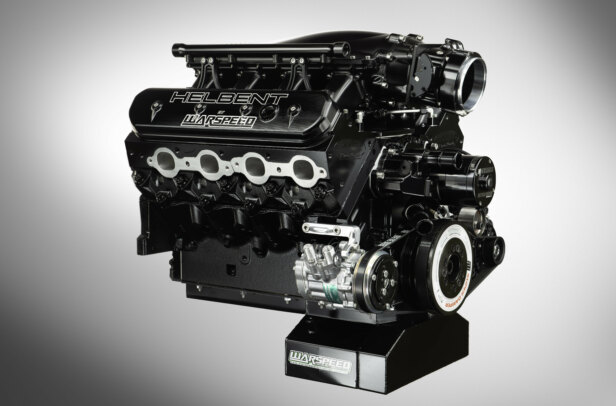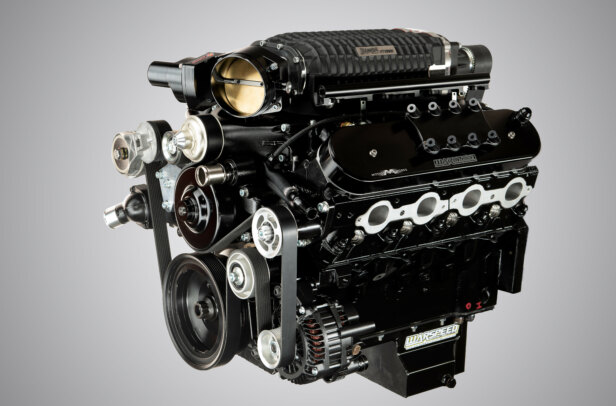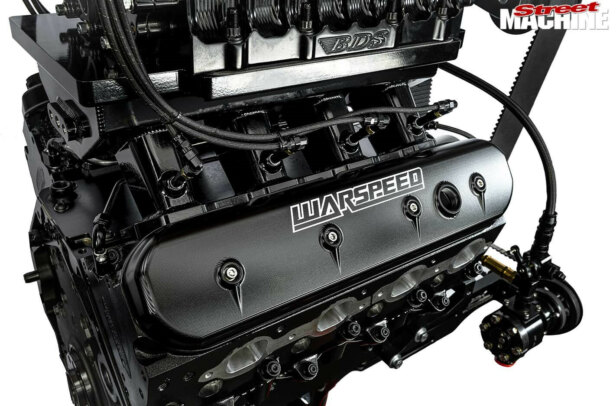TROY David’s epic PRO-J FJ ute (SM, Sep ’19) is an elite-level showstopper that is gunning for the sevens, having already taken out the Red CentreNATS Grand Champion in 2018. Previously, its rotund nose was crammed with a twin-turbo 427ci LSX making 1120rwhp on a soft 18psi, but the Darwin local had always wanted more, so another, far more serious combo was required.
Troy Worsley from Warspeed Industries in Sydney was suggested as the man who could put together this boundary-pushing combo, capable of more than double the ute’s previous best power level.
“We’re only aiming for around 1800hp on E85 with this combo, because that is where the turbos are limited to and the owner doesn’t have much room in the nose of the car itself to fit bigger snails,” Troy W explains. “The engine would support a minimum 2500hp in my eyes, however, and should run to around 7700rpm.”
The foundation of the build is an iron Dart LS Next2 block, for which Troy ticked every box on the option sheet. “We looked at other options, but they were limited by horsepower reliability and the factory engine mounting system in the ute,” says the Warspeed guru. “This is a kebab with the lot, as it has all the options but we still went further. It came washed, prepped and ready to assemble, but we couldn’t order the Torrington bearing conversion, fire rings or screw-in Welch plugs from Dart, so we did that after it arrived.”
The LS Next2 block comes with the choice of LS (2.560in) or larger Ford (2.750in) mains for better bottom-end stability, and is machined with clearance for counterweighted cranks. Another big upgrade over a regular Dart block is the beefy half-inch main studs (and head studs), improving clamping force over the stock 10mm LS items and even the 7/16in studs used in other Dart blocks.
These blocks are available in 9.240-9.450in deck heights to suit a stock cam tunnel, or up to a 9.800in deck height with a 0.388in raised cam tunnel. The FJ will run a standard deck height and cam tunnel.
“The LS Next2 uses steel billet main caps as supplied from Dart, so this type of block takes its own unique cap,” Troy says.
“The block actually comes skirtless from Dart due to the width of the half-inch main caps, so we had to run a bolt-on side skirt to then run a normal LS-configuration oil pan. We actually incorporated the turbo oil drains into the skirts and had them anodised so they blend in.
“The LS Next2 is really its own unique thing. We originally looked at using a Dart SHP Pro block so we didn’t have to run the skirts on the side, but the Ford mains and half-inch main-studs don’t fit the other blocks, as they break through.”
While they’re not common in the street car world, the screw-in Welch plugs make sense when chasing sevens at speeds Doorslammers used to run. Troy had the plugs made by Velocity Engineering, while Wayne Newby clocked a 40mm thread in the burger-with-the-lot block.
“The owner has a speedway background and these are common in that world, so we made the option happen,” Troy says.
“They are very similar to a V8 Supercar. If a cylinder head lifts and you pressurise the cylinders, you won’t pop a Welch plug and get coolant under the back tyres at 170mph.”
The mill swings 427ci courtesy of a Bryant billet crank, Carrillo billet steel rods and custom CP slugs. Even the regular ARP 2000 rod bolts had to be upgraded to the heavier-duty 3.5 fasteners. A Comp Cams solid-roller womp-log runs “around 260s and 270s duration at 0.50in, with north of 750thou lift,” according to Mr Worsley.
“The block has CHE bronze lifter bores to suit the Jesel .937in-diameter keyway lifters,” says Troy. “I used the keywayed individual lifter bodies to eliminate tie-bar issues with them fighting against each other. We’ve gone from an .842in-sized lifter up to a .937in, with 150thou offset to give better angle on the Manton 7/16in pushrods and to clear the port in the head. The pushrods are a 165-wall double-taper item for clearance on the rocker body while still being stronger and resistant to flexing.”
Up top, the 15-degree All Pro LS7-based alloy heads retain the same castings but have had their hardware gone through. “We did the heads in-house, including adding O-rings to the deck face to avoid running gaskets. Custom titanium intake and Inconel exhaust valves were fitted, along with double valve springs, titanium retainers and locks from PAC,” Troy says.
“Looking from the outside in, you don’t pick much, apart from the oil system and Jesel front-drive system, but there is a lot going on in there,” says Troy, adding, “the Jesel front drive requires CNC-machining of the block, which eats into half the oil gallery and means the only way to lubricate the motor is an external oil pump and dry sump. This is why we went for a Tremaniac billet oil pan and an Auto Verdi three-stage pump.
“The Auto Verdi oil pump is also the only external three-stage oil pump we found with a rear hex drive to run a cable-driven fuel pump. We also used an ATI cam sensor kit so you can still run a front-mounted cam sync with the belt drive.”
While the 427 LS will run twin Garrett T51R turbos and a Haltech Elite 2500 ECU, it is actually going to be run in on the engine dyno wearing carburettors for ease of tuning. Once it is installed in the car and the twin Accufab billet throttlebodies are back on the custom Shaun’s Custom Alloy intake, Adam Rogash from MPW and Troy will venture up to Darwin to handle the PgUp key.
“This should be a great combo, and I’m really excited to see what it will do once the car heads back to the track,” says Troy. “I like building LS engines, but it is also great to do something new.”
IN DETAIL:
The front of the angry LS features a monster 55gpm CVR electric water pump, an ATI balancer with rear-facing HTB belt drive for the dry sump, a shielded drive pulley on the dry sump to stop belt walk, a custom timing pointer kit and a Warspeed alternator-only accessory kit
“We used stainless 12-point bolts everywhere to avoid rust in the moist Darwin air, and we’re mounting eight Haltech ignition coils on the valley tray,” Troy says. The custom billet contoured rocker covers were done to look different and to incorporate elements of owner Troy David’s history with sprintcars
ACL-coated bearings were given the nod inside the big-inch little-block, while the CP pistons are hard-anodised on the crowns and skirts, as this helps with combustion temp and cylinder pressures
The Manton 7/16in pushrods won’t flex or deflect under the strains of high rpm and big power, unlike smaller-diameter units found in less serious builds
“This engine uses a custom copper head gasket with Jeff Ramsay fire rings for better sealing under boost. I believe Jeff’s fire rings are the best on the market,” says Troy
Despite such a highly specialised order, and carrying out the build in the depths of COVID, there weren’t too many hold-ups. “The block took 10 months to make and the crank was meant to be delivered in 16 weeks but took seven months to get here, but the rest was not too bad,” Troy says
While LS7 lifters get used in many four-digit LS builds, these Jesel jiggers are a whole other world in hardware. Featuring a larger body, they run in a CHE bronze bush machined into the block, resisting spinning thanks to a keyway
Custom-machined screw-in plugs remove the risk of normal press-fit Welch plugs blowing out and hosing coolant all over the track in the case of a blown head gasket pressurising the cooling system. These had to be expertly machined by Velocity Engineering and Wayne Newby
The stock rockers are a known weak point for big-power LS builds, so this engine runs some serious hardware in this area, with T&D shaft-mount steel rockers with Manton tool-steel adjusters
| TROY DAVID | |
|---|---|
| ENGINE | |
| Block: | Dart LS Next2 |
| Capacity: | 427ci |
| Induction: | Shaun’s Custom Alloy manifold, twin Accufab billet throttlebodies |
| ECU: | Haltech Elite 2500 |
| Turbos: | Two Garrett T51Rs |
| Heads: | All Pro 15-degree LS7-pattern |
| Camshaft: | Comp solid-roller |
| Conrods: | Carrillo steel 6.125in |
| Pistons: | CP custom |
| Crank: | Bryant billet |
| Lifters: | Jesel .937 keyway |
| Rockers: | T&D steel shaft-mount, Manton tool-steel adjusters |
| Pushrods: | Manton 7/16in |
| Oil system: | Tremaniac billet pan, Auto Verdi three-stage dry sump pump |
| Fuel system: | 16 2400cc injectors |
| Exhaust: | Custom MPW turbo manifolds |
| Ignition: | Haltech coils |
THANKS
Troy David for the opportunity to build the engine; Paul at Kavanagh Auto Parts; Adam at Precision International; Trevor at Manton; Joel at Velocity Engineering; Scott Barter from Oxytech; my family for their support




Comments